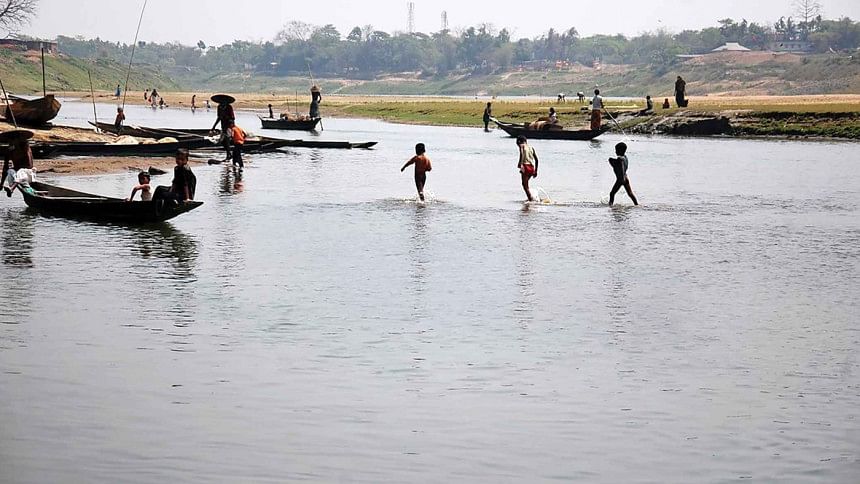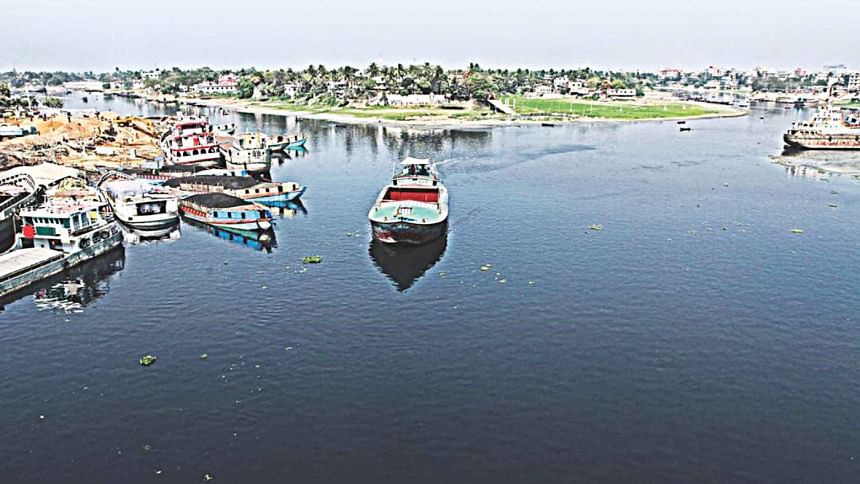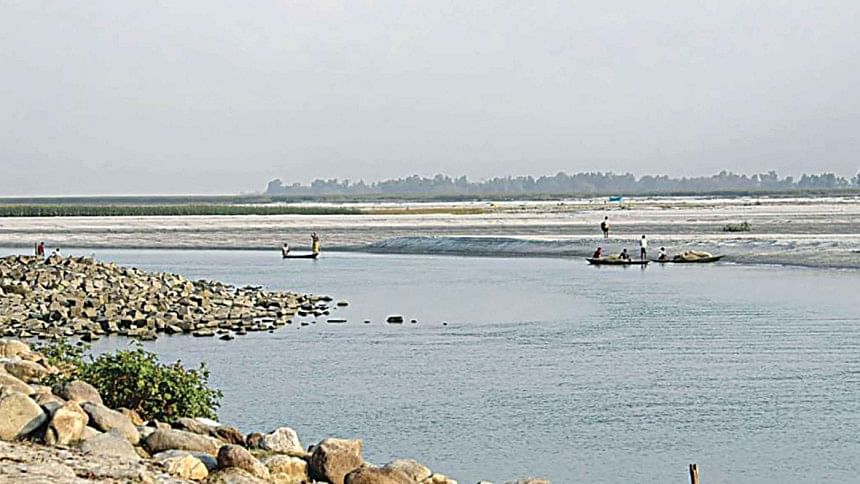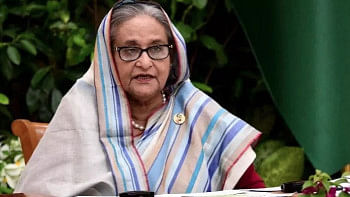Challenges and opportunities of river management

Rivers are priceless gifts of nature to every nation. For "Nodimatrik" Bangladesh they are considered by many as its life-lines equivalent to the veins and arteries of a human body. There are as many as 700 or more names of rivers listed in various archives (Banglapedia, 2019). The Water Development Board, Bangladesh (WDB, 2019) has published documents with names of 406 rivers. This number varies from source to source as some rivers have already vanished with time and some have taken different names at different places. There are 57 international rivers in Bangladesh of which 53 flow from India and 3 from Myanmar.
All rivers influence our everyday life either directly or indirectly as these are potential sources of water for agriculture, fish and also provide an exciting mode of transportation for business and recreation. In order to get the benefits sustainably from our rivers, we need to protect and conserve this bounty of nature. The economy of Bangladesh is heavily dependent on functional waterways and its associated transportation industry. The country with a population of 170 million has about 24,000 km long waterways, where 16 percent (3,800 Km) of it is navigable during dry season and 25 percent (6,000km) during monsoon (BIWTA, 2018). There are almost 12,500 registered vessels for Inland Water Way Transportation as recorded by the Department of Shipping (DOS, 2019). Over a million country boats ply along all water ways which are not registered but impact the economic wellbeing of people. Two major ports of the country handle almost 90 percent of the total import and exports, out of which a major share (more than 85 m Ton per year) is transported hinterland by inland water transports. In the recent past, the government of Bangladesh has strengthened the Protocol of Inland Water Transit and Trade (PIWTT) with India for enhanced opportunities of transboundary trade between the countries. Cargo transport through inland waterways between Bangladesh and India has just nearly doubled to 2.78 MT during FY 2019-20 from 1.44 MT a decade ago, (DS, September 6, 2020, BIWTA). Prime minister Sheikh Hasina has also instructed the concerned ministry for expanding communications with India's north-eastern province of Assam as well as Bhutan and Nepal by waterways. It is, therefore, important to maintain the rivers which are often challenged due to various internal and external issues that need to be resolved for good.

Bangladesh is geographically located in the largest delta of the world, crisscrossed by rivers of different size and length originating mainly from three major river basins namely Ganges, Brahmaputra and Meghna. It has been observed for a long time that the country is put under pressure throughout the year for not getting the rightful share of water from the upstream river systems at its time of need. The dams already built/under construction at the other side of the border have affected the morphology of our major rivers negatively. Consequently, there is a surge of water flow causing inundation during monsoon and again huge shortage of the same during dry season. Both situations usher in great misery for millions of people in Bangladesh.
Again, China's geographical location with respect to both India and Bangladesh, gives it an advantageous edge to regulate the Brahmaputra's water flow. It is said that China has claimed ownership over Tibet's waters, making it an upstream controller of seven of South Asia's mightiest rivers—the Indus, Ganges, Brahmaputra, Irrawaddy, Salween, Yangtze and Mekong. These rivers flow into Pakistan, India, Bangladesh, Myanmar, Laos and Vietnam, and form the largest river run-off from any single position. It is estimated that more than 65 billion tons of surface water flows out of the Tibetan plateau and the Chinese-administered regions of Xinjiang and Inner Mongolia to neighbouring countries each year. China's status as "upper riparian" in this case may put India under different challenges for development. Bangladesh is a lower riparian with respect to India and the equitable distribution of the rivers' waters has since 1970s been a source of friction between the two countries (Britannica, 2019).
History says, there may be complexity of the issues regarding sharing of international waters but disputes can be resolved diplomatically. There are instances of many legal agreements on water sharing, which have been negotiated and maintained even though conflicts have persisted over other issues. Cambodia, Laos, Thailand and Vietnam have been able to cooperate since 1957 within the framework of the Mekong River Commission. Those nations value these agreements because they make international relations over water more stable and predictable. Many of the treaties survived even during war time. The famous Nile River Basin (One of the longest rivers in the world: 6,695 Km) is shared by more than 168 million people of 10 countries (Burundi, DR Congo, Egypt, Eritrea, Ethiopia, Kenya, Rwanda, South Sudan, The Sudan, and Tanzania) because of successful partnership. These are good examples of international water resource cooperation supported by third-party-fund trusted by all stakeholders. Looking at 145 sectoral distribution of agreements on transboundary water resources, almost 76 percent of agreements were on the "use and hydropower of water" and rest due to navigation, flood control, pollution etc (UNDESA, 2005-2015). For such agreements to succeed the most important requirements so far noticed have been proper monitoring and mechanism for enforcement.
For managing international rivers, the 1997 United Nations Convention on Non-Navigational Uses of International Watercourses is one important instrument that specifically focuses on shared water resources. It established two key principles to guide the conduct of nations regarding shared watercourses: "equitable and reasonable use" and "the obligation not to cause significant harm" to neighbours. Article 5, contained in Part II, reflects the principle that is widely viewed as the foundation of the Convention: equitable and reasonable utilisation and participation. It requires that a State sharing an international watercourse with other States utilise the watercourse, in its territory, in a manner that is equitable and reasonable vis-à-vis the other States sharing it. Another important provision of the Convention is article 7 (Obligation not to cause significant harm). This article requires that States "take all appropriate measures to prevent the causing of significant harm" to other States sharing an international watercourse. Very often the two articles are combined somewhat as follows: if a State believes it has sustained notable harm due to a co-riparian State's use of an international watercourse, it will simply raise the issue with the second State. In the negotiations that follow, articles 5, 6 and 7 in effect provide that the objective is to reach a solution that is equitable and reasonable with regard to both States' use of the watercourse and the benefits they derive from it. However, it is up to the participating bodies themselves to determine what these terms would mean for their own benefits. The experts on the subject should coordinate in a way that international watercourse agreements be concrete, outline measures to enforce treaties made and incorporate detailed conflict resolution mechanisms in case disputes arise. The treaty also requires states to take reasonable steps to control damage due to any reason. It must include provisions for managing damage to waterways, such as caused by drought or erosion, and mandated that sharing states notify immediately of emergency conditions related to the watercourse that may affect them.
A new move under "South Asia Water Initiative (SAWI)" has been well appreciated by different corners. The multi-donor trust fund of SAWI is supported by the United Kingdom, Australia, and Norway, and administered by the World Bank. Their activities focus on three river basins (Indus, Brahmaputra and Ganges) including Sundarbans area with broad objectives of strengthening awareness and knowledge about regional water issues focusing seven countries namely, Afghanistan, Bangladesh, Bhutan, China, India, Nepal and Pakistan. As long as the initiatives are not against the interest of any sovereign country, the endeavours may sustain for longer period.
Within Bangladesh, management of river and its maintenance is a colossal task for the nation. Our governments have been always striving hard to address the internal water related issues with maximum priority. Several laws have been enacted in this regard. But the major problem is with implementation. Our constitution has clearly indicated via Article 18(A) that: "The State shall endeavour to protect and improve the environment and to preserve and safeguard the natural resources, bio-diversity, wetlands, forests and wild life for the present and future citizens".Other relevant acts are Bangladesh Water Act 2013 (Act no. 14 of 2013), National River Protection Commission (NRPC) Act, 2013, and The Environment Conservation Act, 1995 (upgraded in 2010).

The NRPC has started functioning in the form of "Coordination Bridge Ties", as stated by them. Some commendable steps have been taken by the commission, where one of it is making a list of 42,423 persons who have encroached upon rivers all around the country (Prothom Alo, August 26, 2019). It also appears that the NRPC has a very challenging task ahead with limited resources. There have been criticisms already at the early stages that have pointed that the NRCC is simply a recommending body without any statutory power of implementation. Placement of this important organisation under the administrative control of the Ministry of Shipping has been another debatable item. This has been questioned by several professionals, since river and water bodies fall in the sphere of the Ministry of Water Resources as per related rules of business. However, the country is yet to see its potential in making positive headway under specific vision covering comprehensive mission with a timeframe. It is important that this institution is manned by dedicated, trained and efficient staff who can really work as per the set objectives.
Currently, the deplorable state of rivers besides the major cities of Bangladesh, say eight divisional cities /towns, speak of the true story about the respective stakeholders' concerns to the available legal framework. Worst performers so far noticed are in Dhaka, where damages on three adjacent rivers, Buriganga, Turag and Balu are notoriously visible. Lately, the river Dhaleshwari is also being polluted at a faster pace due to the ill management of tannery factories' treatment plants. Rangpur district town, though never marked by anyone for harming the almost dead river Ghagat nearby, deserves to be listed along with the capitol city for not doing enough to protect the river. Mymensingh also has the responsibility to give life support to its already half dead river called the old Brahmaputra. Recent initiative to conduct some dredging to revive it by the government is appreciated. Similarly, all other rivers on the banks of which urbanisation has taken place need to be maintained and conserved up to a standard acceptable by any safety authority for health, environment and infrastructure. The cities which have grown more industrial are on the top of the list having polluted rivers and potential land grabbers. Presently, offices of all the district administrators are having colourful websites, which could be asked to electronically publish the quality of waters of respective rivers along with other important information on a regular basis. This can help monitoring activities and general people would also know the standard of river water management.
In the overall management of the river system, a number of organisations are responsible. Overlapping areas of responsibilities by stakeholder groups need to be clarified by proper coordination. River management is very important to control flood water, embankment erosion and navigability. Rivers need to be controlled which is an important task for social scientists, environmentalists, along with civil and water resources engineers. In reality it is an expensive affair which is found to be difficult worldwide. That is why there are many unsuccessful stories on river management. But what has been successful around the globe is sharing water resources by countries through cooperated actions under good political intentions. Over and above, if strong political will and control backed by peoples' aspiration and support is not there from national and international organisations, every endeavour may fail.

A quotation from the former Secretary General of United Nations reminds us of the importance of rightful sharing of international rivers. He said, "Fierce national competition over water resources has prompted fears that water issues contain the seeds of violent conflict. If all the world's peoples work together, a secure and sustainable water future can be ours". Through fair politics and diplomacy all possible areas of cooperation may be explored to take maximum benefit from the natural resources of the region.
Management of natural resources in general and river water in particular are among the very critical challenges encountered by most developing countries in the world and Bangladesh is no exception. Severe competitions in exploitations of resources and improper handling of the issues by political masters have been cause of conflicts in many places. Mistrust, lack of governance, mismanagement and non-cooperation on equitable sharing of river waters may damage harmony, peace and slow down long-term development within the country or the region. With change of climate there is again urgency for strengthening water governance, which must be addressed with due care.
Now, the most important step for proper management of rivers is preparing human resources to deal with the issues for both short and long term. Education and training on use and maintenance of rivers along with appropriate legal framework is a must. We need to prepare experts on water resources engineering and management, legal experts on dispute negotiation and resolution. Political strength should be utilised properly to engage all concerned with riparian and domestic water users' groups. Water resources professionals have to learn how to plan, design, build, and operate structures that together with non-structural measures increase the benefits people can obtain from the water resources contained in aquifers, lakes, rivers, and estuaries. Bangladesh needs to have her rivers (life-lines) well protected against all threats for the benefit of its economy and for the survival of millions of its people.
Rear Admiral ASM Abdul Baten (Rtd) is former Vice Chancellor of Bangabandhu Sheikh Mujibur Rahman Maritime University, Fellow FIEB and National Defence College Bangladesh.

 For all latest news, follow The Daily Star's Google News channel.
For all latest news, follow The Daily Star's Google News channel. 



Comments